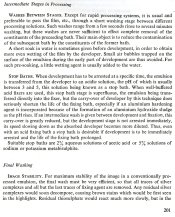Lets have some honesty, the facts are all in the references I've posted and Ron - PE's done the same, there's no disputing any of those facts it's how they are interpreted. What I've said all along is that Ron (PE) was repeatedly interpreting those facts to promote one side of the stop bath or rinse, and I've told him in more than one post that those arguments were bullshit, I still think so. However he's re-evaluated some of the references in the more recent posts and changed his stance.
We need to step back to basics which I posted before & linked to again in this thread, here it is yet again:
Summing up
A stop bath is not necessary at all, neither is a water rinse.
Mason states clearly the stage is superfluous to the overall processing of films or papers, and this is also backed up by both Fuji & Kodak who include no rinse or stop in their mechanic film processing data & Ilford who state that there should be no problem in machines with no facility for a stop bath. That's for films and RC papers.
Needs very good agitation to prevent dichroic fogging.
We are talking about using a stop bath or water rinse not leaving the stage out:
1. A stop baths purpose is not the removal of all residual developing agents. There's insufficient time, this will continue during fixing and washing.
2. The purpose of a water rinse or stop bath is the slowing of development, which is more immediate with an acid stop bath
3. The second purpose of a water rinse or stop bath is minimising the carry over of developer into the fixer.
4. The advantage of a stop bath is that the pH of the film has been changed, so helping preserve the buffering of the (acid) fixer, potentially prolonging the fixers life & throughput.
5. Stop bath is detrimental with some soft emulsion films with certain developers, due to pin hole issues.
6. If no stop bath is used there have been reports of Dichroic fogging before an Alkaline/Neutral fixer, but in numerous threads Ron (PE) has always recommended the use of a stop bath before TF-4.
It's up to people to decide which of the manufacturers recommendations they use water rinse or stop bath.
It's also important to remember that modern films are thinner, many have much better hardening of their emulsions, fixers are now predominantly ammonium thiosulphate based “Rapid Fixers”. This means that there's less retention of developer in modern emulsions, also that fixing is more immediate after a stop bath or rinse stage, (with a rapid fixer).
If we relate this to films we can see why the manufacturers still recommend a stop bath or rinse.
With RC papers the issue is large volumes of rinse water would be needed depending on the number of prints processed instead of a much smaller volume of stop bath, machine processing leaves out the step entire in many cases but chemistry is usually removed by passing between rollers so there's little carry over.
With fibre based papers the carry over issue is very much more significant as there's chemistry in the paper base, so a stop bath is imperative. There is still some significant carry over of developer, albeit neutralised, which is one reason why manufacturers recommendations of fixer capacity are fewer prints per litre of fixer when you look at data for FB and then RC papers. That's also borne out in practical experience.
I have no qualms about disagreeing about an issue like this, whether that's with Ron (PE) or anyone else, the facts are plain to see. Possibly only one person Q.G. has actually taken the time to read all the posts in this thread properly.
Ian











 So making a comment like you have twice now are just attacks as I said before. The point's there because it indicates that a stop or rinse isn't required for the removal of developer & byproducts carried over in an emulsion, I don't think anything else can be read into it at all.
So making a comment like you have twice now are just attacks as I said before. The point's there because it indicates that a stop or rinse isn't required for the removal of developer & byproducts carried over in an emulsion, I don't think anything else can be read into it at all.
 ) re the view you don't prefer.
) re the view you don't prefer.